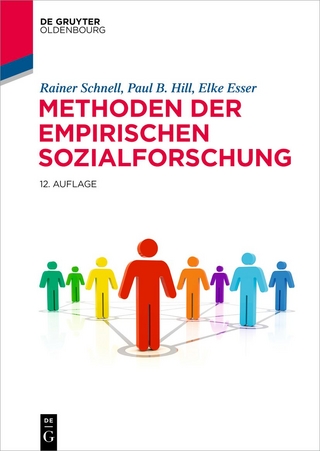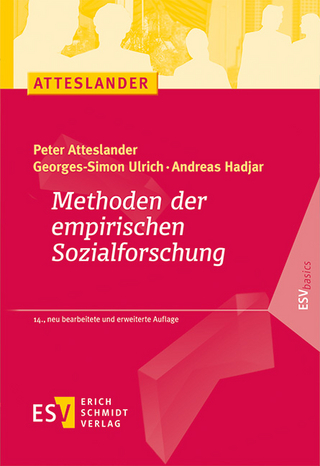
Structural Equation Modeling
John Wiley & Sons Inc (Verlag)
978-1-119-42270-9 (ISBN)
Focusing on the conceptual and practical aspects of Structural Equation Modeling (SEM), this book demonstrates basic concepts and examples of various SEM models, along with updates on many advanced methods, including confirmatory factor analysis (CFA) with categorical items, bifactor model, Bayesian CFA model, item response theory (IRT) model, graded response model (GRM), multiple imputation (MI) of missing values, plausible values of latent variables, moderated mediation model, Bayesian SEM, latent growth modeling (LGM) with individually varying times of observations, dynamic structural equation modeling (DSEM), residual dynamic structural equation modeling (RDSEM), testing measurement invariance of instrument with categorical variables, longitudinal latent class analysis (LLCA), latent transition analysis (LTA), growth mixture modeling (GMM) with covariates and distal outcome, manual implementation of the BCH method and the three-step method for mixture modeling, Monte Carlo simulation power analysis for various SEM models, and estimate sample size for latent class analysis (LCA) model.
The statistical modeling program Mplus Version 8.2 is featured with all models updated. It provides researchers with a flexible tool that allows them to analyze data with an easy-to-use interface and graphical displays of data and analysis results.
Intended as both a teaching resource and a reference guide, and written in non-mathematical terms, Structural Equation Modeling: Applications Using Mplus, 2nd edition provides step-by-step instructions of model specification, estimation, evaluation, and modification. Chapters cover: Confirmatory Factor Analysis (CFA); Structural Equation Models (SEM); SEM for Longitudinal Data; Multi-Group Models; Mixture Models; and Power Analysis and Sample Size Estimate for SEM.
Presents a useful reference guide for applications of SEM while systematically demonstrating various advanced SEM models
Discusses and demonstrates various SEM models using both cross-sectional and longitudinal data with both continuous and categorical outcomes
Provides step-by-step instructions of model specification and estimation, as well as detailed interpretation of Mplus results using real data sets
Introduces different methods for sample size estimate and statistical power analysis for SEM
Structural Equation Modeling is an excellent book for researchers and graduate students of SEM who want to understand the theory and learn how to build their own SEM models using Mplus.
Jichuan Wang, PhD, is Professor in the Department of Pediatrics, Epidemiology, and Biostatistics at the George Washington University (GWU) School of Medicine. He also serves as Senior Biostatistician in the National Children's Medical Center (CNMC) in Washington, DC. Xiaoqian Wang, PhD, is a Principle Consultant at Mobley Group Pacific Ltd., P.R. China.
Preface ix
1 Introduction to structural equation modeling 1
1.1 Introduction 1
1.2 Model formulation 3
1.2.1 Measurement models 4
1.2.2 Structural models 6
1.2.3 Model formulation in equations 7
1.3 Model identification 11
1.4 Model estimation 14
1.4.1 Bayes estimator 17
1.5 Model fit evaluation 19
1.5.1 The model 𝜒2 statistic 20
1.5.2 Comparative fit index (CFI) 20
1.5.3 Tucker Lewis index (TLI) or non-normed fit index (NNFI) 21
1.5.4 Root mean square error of approximation (RMSEA) 22
1.5.5 Root mean-square residual (RMR), standardized RMR (SRMR), and weighted RMR (WRMR) 22
1.5.6 Information criteria indices 24
1.5.7 Model fit evaluation with Bayes estimator 25
1.5.8 Model comparison 26
1.6 Model modification 27
1.7 Computer programs for SEM 28
Appendix 1.A Expressing variances and covariances among observed variables as functions of model parameters 30
Appendix 1.B Maximum likelihood function for SEM 32
2 Confirmatory factor analysis 33
2.1 Introduction 33
2.2 Basics of CFA models 34
2.2.1 Latent variables/factors 39
2.2.2 Indicator variables 39
2.2.3 Item parceling 40
2.2.4 Factor loadings 42
2.2.5 Measurement errors 42
2.2.6 Item reliability 44
2.2.7 Scale reliability 44
2.3 CFA models with continuous indicators 45
2.3.1 Alternative methods for factor scaling 52
2.3.2 Model estimated item reliability 57
2.3.3 Model modification based on modification indices 57
2.3.4 Model estimated scale reliability 58
2.3.5 Item parceling 60
2.4 CFA models with non-normal and censored continuous indicators 61
2.4.1 Testing non-normality 61
2.4.2 CFA models with non-normal indicators 62
2.4.3 CFA models with censored data 67
2.5 CFA models with categorical indicators 70
2.5.1 CFA models with binary indicators 72
2.5.2 CFA models with ordinal categorical indicators 76
2.6 The item response theory (IRT) model and the graded response model (GRM) 77
2.6.1 The item response theory (IRT) model 77
2.6.2 The graded response model (GRM) 86
2.7 Higher-order CFA models 91
2.8 Bifactor models 96
2.9 Bayesian CFA models 102
2.10 Plausible values of latent variables 110
Appendix 2.A BSI-18 instrument 113
Appendix 2.B Item reliability 114
Appendix 2.C Cronbach’s alpha coefficient 116
Appendix 2.D Calculating probabilities using probit regression coefficients 117
3 Structural equation models 119
3.1 Introduction 119
3.2 Multiple indicators, multiple causes (MIMIC) model 120
3.2.1 Interaction effects between covariates 126
3.2.2 Differential item functioning (DIF) 127
3.3 General structural equation models 137
3.3.1 Testing indirect effects 141
3.4 Correcting for measurement error in single indicator variables 144
3.5 Testing interactions involving latent variables 150
3.6 Moderated mediating effect models 153
3.6.1 Bootstrap confidence intervals 159
3.6.2 Estimating counterfactual-based causal effects in Mplus 160
3.7 Using plausible values of latent variables in secondary analysis 164
3.8 Bayesian structural equation modeling (BSEM) 167
Appendix 3.A Influence of measurement errors 173
Appendix 3.B Fraction of missing information (FMI) 175
4 Latent growth modeling (LGM) for longitudinal data analysis 177
4.1 Introduction 177
4.2 Linear LGM 178
4.2.1 Unconditional linear LGM 178
4.2.2 LGM with time-invariant covariates 184
4.2.3 LGM with time-invariant and time-varying covariates 189
4.3 Nonlinear LGM 192
4.3.1 LGM with polynomial time functions 192
4.3.2 Piecewise LGM 203
4.3.3 Free time scores 210
4.3.4 LGM with distal outcomes 211
4.4 Multiprocess LGM 216
4.5 Two-part LGM 221
4.6 LGM with categorical outcomes 229
4.7 LGM with individually varying times of observation 238
4.8 Dynamic structural equation modeling (DSEM) 241
4.8.1 DSEM using observed centering for covariates 241
4.8.2 Residual DSEM (RDSEM) using observed centering for covariates 245
4.8.3 Residual DSEM (RDSEM) using latent variable centering for covariates 248
5 Multigroup modeling 253
5.1 Introduction 253
5.2 Multigroup CFA models 254
5.2.1 Multigroup first-order CFA 258
5.2.2 Multigroup second-order CFA 289
5.2.3 Multigroup CFA with categorical indicators 306
5.3 Multigroup SEM 316
5.3.1 Testing invariance of structural path coefficients across groups 322
5.3.2 Testing invariance of indirect effects across groups 326
5.4 Multigroup latent growth modeling (LGM) 327
5.4.1 Testing invariance of the growth function 332
5.4.2 Testing invariance of latent growth factor means 335
6 Mixture modeling 339
6.1 Introduction 339
6.2 Latent class analysis (LCA) modeling 340
6.2.1 Description of LCA models 341
6.2.2 Defining the latent classes 347
6.2.3 Predicting class membership 347
6.2.4 Unconditional LCA 348
6.2.5 Directly including covariates into LCA models 360
6.2.6 Approaches for auxiliary variables in LCA models 363
6.2.7 Implementing the PC, three-step, Lanza’s, and BCH methods 365
6.2.8 LCA with residual covariances 370
6.3 Extending LCA to longitudinal data analysis 373
6.3.1 Longitudinal latent class analysis (LLCA) 373
6.3.2 Latent transition analysis (LTA) models 375
6.4 Growth mixture modeling (GMM) 392
6.4.1 Unconditional growth mixture modeling (GMM) 394
6.4.2 GMM with covariates and a distal outcome 402
6.5 Factor mixture modeling (FMM) 411
6.5.1 LCFA models 417
Appendix 6.A Including covariates in LTA model 418
Appendix 6.B Manually implementing three-step mixture modeling 434
7 Sample size for structural equation modeling 443
7.1 Introduction 443
7.2 The rules of thumb for sample size in SEM 444
7.3 The Satorra-Saris method for estimating sample size 445
7.3.1 Application of The Satorra-Saris method to CFA models 446
7.3.2 Application of the Satorra-Saris’s method to latent growth models 454
7.4 Monte Carlo simulation for estimating sample sizes 458
7.4.1 Application of a Monte Carlo simulation to CFA models 459
7.4.2 Application of a Monte Carlo simulation to latent growth models 463
7.4.3 Application of a Monte Carlo simulation to latent growth models with covariates 467
7.4.4 Application of a Monte Carlo simulation to latent growth models with missing values 469
7.5 Estimate sample size for SEM based on model fit indexes 473
7.5.1 Application of the MacCallum–Browne–Sugawara’s method 474
7.5.2 Application of Kim’s method 477
7.6 Estimate sample sizes for latent class analysis (LCA) model 479
References 483
Index 507
| Erscheinungsdatum | 24.10.2019 |
|---|---|
| Reihe/Serie | Wiley Series in Probability and Statistics |
| Verlagsort | New York |
| Sprache | englisch |
| Maße | 152 x 229 mm |
| Gewicht | 794 g |
| Themenwelt | Mathematik / Informatik ► Mathematik |
| Sozialwissenschaften ► Soziologie ► Empirische Sozialforschung | |
| ISBN-10 | 1-119-42270-1 / 1119422701 |
| ISBN-13 | 978-1-119-42270-9 / 9781119422709 |
| Zustand | Neuware |
| Haben Sie eine Frage zum Produkt? |
aus dem Bereich


